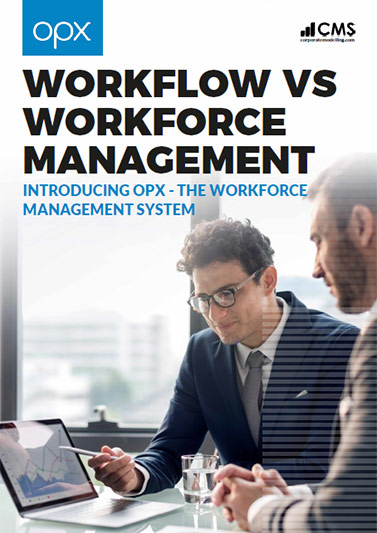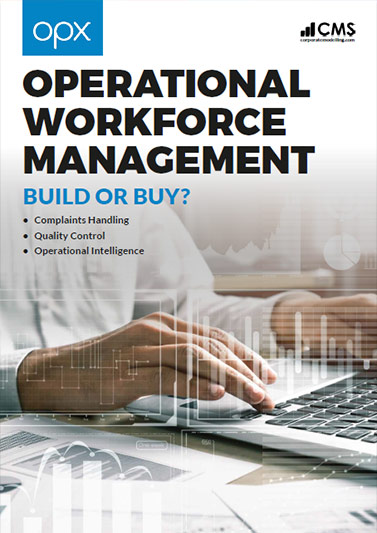Workforce Optimisation
Optimise your staff and processes. As a workforce optimisation system, OPX provides a wide range of benefits.
OPX is proven to increase productivity and utilisation, reduce costs, cycle times and complaints while improving quality and customer service.


Optimisation of service delivery to customers
Improvement in workforce productivity and performance
Support in monitoring workforce wellbeing
Automation of case handling using RPA
Reduction in operational costs
Reduction of failure in meeting customer demand
Freeing up valuable resources
Improved management oversight
Meeting Service Demand
By providing a platform that offers solutions to the tasks listed above, OPX has been developed to achieve one main goal – to meet service demand in businesses such as yours.
OPX is flexible and scalable. It can be suited to any company’s needs and developed further at any time – by adding modules and automating other processes.

Award-Winning Software
In conjunction with HCL IBS and Admin Re, OPX, our digital transformation solution, won the WfMC award for Excellence in BPM & Workflow for two successive years.
The Benefits of using OPX
Why should I use OPX?
If you are looking to improve customer outcomes, operational efficiency, employee performance and where relevant regulatory compliance – OPX is the right solution for you. Our experience implementing OPX has achieved:
- 20% increase in business efficiency
- 29% increase in number of transactions
- 21% increase in utilisation
- 12% improved quality (RFT)
- 70% complaints volume reduction
- 32% reduction in operational costs
These measures are attained as OPX supports the business by providing:

Performance boost
With process automation, tasks become easier to handle. The workforce performs its job faster and makes fewer mistakes as automated processes are less complicated.

Workforce productivity monitoring
The system provides the management and team leader dashboard that helps to monitor workforce productivity and find their strengths and weaknesses.

Resource time management and support
Agents report on their work timeline by clocking-in and out of shifts and breaks. Team leaders can see how long it takes to perform each tasks and identify whenever an agent requires support.

Upskilling and training efficiency
Having a comprehensive overview of workforce strengths and weaknesses helps to identify the training needs.

Reporting based on real-time data
A broad range of reports available helps to overview the process of achieving the performance benchmarks.

Support in finding and removing the bottlenecks
The performance monitoring dashboards and the report generation help identify the bottlenecks of the current back-office processes.

Management oversight of service delivery
Complex reports and tools are available to monitor workforce efficiency to give an overview of KPIs achieved compared with agreed targets.

Customer complaint reduction and increased satisfaction
Reduced mistakes and quicker processing directly influences the volume of customer complaints.
Core Modules
OPX Architecture
OPX is a granular solution, consisting of many modules. Each module can be added with time – when deciding to develop your business automation further. Expand the sections below for more information.
OPX Application Discovery (OAD) is a module developed in consideration with companies that enable remote and hybrid working. OAD offers a complex overview of employees activities and performance in real-time. Apart from complex reports, OAD shows a mouse activity and screen preview.
The module was developed to help with:
- Assisting with meeting compliance and audit requirements
- Assisting with monitoring work-mental-health of remote team members
- Enabling a hybrid and flexible working regime
- Encouraging employees to evaluate their own scoring and start self-improving
- Identifying over-working and ‘always on’ behaviours that lead to burnout
- Tracking if employees are using any unsanctioned IT apps
- Discovering what apps are used for each process activity
- Better analysis of Idle time during the day
- Ability to see robotics opportunities for providing a service to speed up case working at an activity
The OPX Team Leader Console is the OPX command and control centre.
Depending on the assigned within the system permissions, operation managers or team leaders can configure the operations’ hierarchy, locations, team structures (including robots), team members, shift patterns, skill profiles and business processes together with appropriate service level agreements (SLAs).
The process configured for each team and team member is automatically assigned and communicated through the OPX User App.
To meet the needs identified by real-time reports and forecast models, team members (including robots) can be dynamically re-assigned to meet changes in work volumes or complexity based on skill levels and availability.
The OPX User App is a highly configurable application designed to guide, prompt and enable individual agents to process work efficiently based on skill levels and the needs of the business.
The intuitive, icon-based interface is the key to managing how and when the tasks get processed. The “Get Next” option selects the next work item from the queue based on the skills level of the agent, SLA or other criteria set by the team leader, preventing “cherry-picking” of the simplest cases.
All options are configured via the OPX Team Leader Console by team leaders or managers. An agent’s actions, times, and decisions are recorded through the Workflow Manager to analyse individual, team or department performance. This enables the monitoring and immediate fine-tuning of work and processes to meet quality or SLA targets.
Each work item has its processing history available. That is associated correspondence, documents, notes or other relevant information from the OPX system or any supporting back-office system.
Pre-configured checklists guide the agent through the task together with options to defer, pause, pass ownership, or escalate if other departments need to be consulted, information needs to be requested, or simply take a break or attend a meeting.
OPX tracks the demand for services in real-time from multiple channels, including scan and index imports, call centre and IVR interfaces, email and SMS messages, and manually and automatically (through a web portal) generated requests.
OPX provides global demand visibility and can show in real-time the workload in dashboards and reports, online and sliced and diced as required.
OPX can automatically allocate work in real-time based on SLAs, volume and type of work matched to the available resource capacity and skills. It also allows managers to make a change and allocate work manually in order to meet unexpected or changing circumstances.
The automatic work assignment prevents “cherry-picking” when agents select the work directly from a queue. ‘Cherry picking’ of tasks can lead to work or cases moving out of an agreed SLA due to its perceived complexity.
Real-life example:
One of our customers moved work from India to the UK during a period of national mourning. The move took place in minutes of the management being notified by OPX that the Indian teams had clocked off, enabling managers to re-prioritise outstanding work allocations and move them back to the UK.
Benefits of using Real-time Work Allocation Module:
- Automatically matches work with resources
- Prevents agent self-selection
- Enables immediate re-allocation of work to meet changing priorities
- Helps consistently meet SLAs
OPX Reports and Dashboards is the Management Information System (MIS) hub of the OPX solution.
OPX Reports and Dashboard provide visibility on productivity, utilisation, SLA or process status (case, policy, complaints etc.) give managers unrivalled agility to plan, monitor and tune their operations.
By using a built-in report generator and re-useable widgets, reports and dashboards can be easily created, stored and run on-demand within OPX.
Providing real-time and archive data, including information about:
- Processes
- Team Members
- Automated tasks (robots)
- Teams
- Departments
Operations data captured by OPX can be easily integrated with third-party business information and spreadsheets applications for aggregation, reporting and presentation with other data sources.
Operations team members must make decisions all the time. While there will never be a valid substitute for human deductive reasoning, there are often cases where the decision required is a complex and fast business rule.
For example, a decision that involves late payments. The customer needs to be chased by a letter, then by an email, and then added to the outbound caller queue.
These decisions are complex, and the rules involving them can be set up within the OPX Decision Engine.
Decisions can be created about many work items in queues. The engine allows defining who, what and when.
It also offers an option for creating new data items against processed cases, such as a field with days overdue, or information on how to handle the results, including bot involvement, data gathering or necessity of human involvement in handling the case.
The OPX Planning and Scheduling Module is an integrated part of the OPX suite, capturing and planning: individual, team and departmental activity. It saves the cost and decreases the complexity of maintaining and integrating third-party applications.
Aimed at team leaders and resource planners, the module is highly configurable to create individual, team, and departmental shift patterns. Multiple users’ calendar previews can be configured to check if the resources match the volume and timing of forecasted or actual work.
Calendar previews can be shown for individual (for day-to-day management and review purposes), shift, team or department for an immediate (today) or any given time. Departmental, individual, team and company activities, such as holidays, meetings, training etc., are automatically added to each calendar to ensure a comprehensive preview of resources available.
Information captured by the Intelligent Agent Assist (IAA) links to the shift or calendar previews, enabling managers to decide when and where to make immediate adjustments to a shift pattern.


 Thank you for your interest in our whitepaper. You can download Workforce Optimisation vs Workforce Management by clicking the button below.
Thank you for your interest in our whitepaper. You can download Workforce Optimisation vs Workforce Management by clicking the button below. Thank you for your interest in our case study. You can download the HCL IBS Case Study by clicking the button below.
Thank you for your interest in our case study. You can download the HCL IBS Case Study by clicking the button below. Thank you for your interest in our case study. You can download the ReAssure Case Study by clicking the button below.
Thank you for your interest in our case study. You can download the ReAssure Case Study by clicking the button below. Thank you for your interest in our case study. You can download the Student Loans Case Study by clicking the button below.
Thank you for your interest in our case study. You can download the Student Loans Case Study by clicking the button below. Thank you for your interest in our case study. You can download the Principality Building Society Case Study by clicking the button below.
Thank you for your interest in our case study. You can download the Principality Building Society Case Study by clicking the button below. Thank you for your interest in our whitepaper. You can download WorkFlow vs WorkForce Management by clicking the button below.
Thank you for your interest in our whitepaper. You can download WorkFlow vs WorkForce Management by clicking the button below. Thank you for your interest in our whitepaper. You can download Homeworking in Financial Services Operations by clicking the button below.
Thank you for your interest in our whitepaper. You can download Homeworking in Financial Services Operations by clicking the button below. Thank you for your interest in our whitepaper. You can download Workforce Optimisation for the Back Office by clicking the button below.
Thank you for your interest in our whitepaper. You can download Workforce Optimisation for the Back Office by clicking the button below. Thank you for your interest in our whitepaper. You can download Operational Workforce Management: Build or Buy? by clicking the button below.
Thank you for your interest in our whitepaper. You can download Operational Workforce Management: Build or Buy? by clicking the button below. Thank you for your interest in our whitepaper. You can download Homeworking & Back Office Workforce Optimisation by clicking the button below.
Thank you for your interest in our whitepaper. You can download Homeworking & Back Office Workforce Optimisation by clicking the button below. Thank you for your interest in our whitepaper. You can download Why Optimise in the Back Office? by clicking the button below.
Thank you for your interest in our whitepaper. You can download Why Optimise in the Back Office? by clicking the button below.